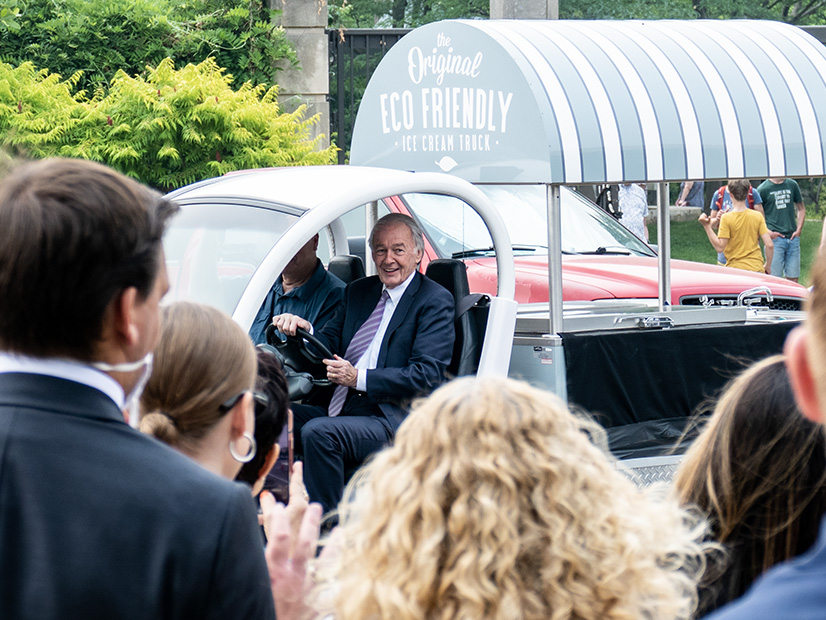
WASHINGTON — With hazy skies in the nation’s capital produced by Canadian wildfires, clean transportation nonprofit CALSTART brought four commercial electric vehicles to the foot of Capitol Hill on Wednesday for a press event with some of the industry’s supporters in Congress.
CALSTART works with governments and industry to develop clean and efficient transportation solutions. Its members include Audi, Ford, General Motors and Volvo.
Sen. Martin Heinrich (D-N.M.) said the assembled vehicles showed that the industry had made major strides and was ready for real-world use. The vehicles included a Nikola semitruck, a Workhorse box delivery truck, a Monarch Tractor and an electric ice cream truck.
“They just do the job better, and it couldn’t come at a more important time,” Heinrich said, referencing the haze and low air quality from the wildfires. “Those of us in the West are familiar with this. We’ve lived with it for 15 to 20 years now. This is the result of 100 years of burning fossil fuels. And it means we’re now burning our forests because the planet is a warmer place.”
Decarbonizing transportation is key to limiting further impacts from global warming, and while commercial vehicles represent just 5% of the overall fleet, they are a quarter of the sector’s emissions, Heinrich said.
“We won’t be able to tackle the challenge without setting the most ambitious standards to lead transportation emissions and move the market through policy,” Sen. Alex Padilla (D-Calif.) said.
Padilla grew up in Los Angeles, which historically had such bad air quality that he would sometimes be sent home from school because of it. As a tour bus’ diesel engine rumbled past, he described riding to and from school in yellow buses with the same engines and recalled their smell.
“You can imagine the health issues and the learning issues that that would lead to,” Padilla said. “We refuse to accept that as normal and will not impose that same reality, the same environmental harm and health risk on future generations. That’s why California is proud to have set some ambitious goals when it comes to tackling emissions. No state has fought harder to transition to electric vehicles than California.”
The state wants to get to 100% emissions-free medium- and heavy-duty trucks by 2045, he added.
CALSTART worked with the California Air Resources Board to get those first-in-the-nation regulations passed, which have now been adopted by another nine states, organization President John Boesel said.
“What’s really important now is that the U.S. EPA is considering regulations in this space,” Boesel said. “And they have a draft regulation that’s out there for comment, and industry and others are providing input.”
The industry already offers more than 100 types of zero-emission commercial vehicles, especially in states that offer their own incentives on top of those from the Inflation Reduction Act, he added.
“Those vehicles are cost effective today,” Boesel said. “They have much lower operating costs than their diesel equivalent. And that includes both the cost of electricity and maintenance costs. And I think as we see battery technology improve, that business case is only going to get better and better.”
Innovation to limit carbon emissions used to be something to look forward to, but it is here now, Rep. Paul Tonko (D-N.Y.) said.
“Trucks and buses that are the backbone of our current economy, that provide vital services to our communities, can be run in a clean and effective manner,” Tonko said. “These vehicles in the past have disproportionately contributed to air pollution.”
The Biden administration was also represented at the event through the Joint Office of Energy and Transportation, in which the respective departments coordinate their efforts on EVs. Executive Director Gabe Klein said he came from the business world, where he set up an organic food truck company with 16 EVs in the 2000s, when there was nowhere to charge them, not even in D.C.
“The world has changed dramatically, and now these vehicles are mainstream,” Klein said. “And our job at the joint office … is to bring together DOT, DOE and all the resources within the federal government to help to get this job done.”
President Joe Biden set a goal for the U.S. to have 500,000 EV chargers by 2030. The country added 21,000 chargers last year, up from an average of about 5,000 a year, and now the country has about 143,000 in total.
Nikola is building semitrucks out of its factory in Arizona that are aimed at dealing with regional cargo transportation needs with a range of 330 miles, said senior manager for state and local affairs William Higgins. The trucks are already being used at Los Angeles International Airport and the nearby ports of Long Beach and Los Angeles.
“Nikola believes that the electrification of the medium- and heavy-duty sector is critical to reducing carbon emissions given that, on average, one zero-emission truck avoids 106 metric tons of CO2 annually,” Higgins said.
The firm is also to release a hydrogen fuel cell truck this year, with a range of 500 miles that can be used for longer-distance cargo, he added. Nikola also early this year launched its own hydrogen fuel brand, called HYLA, to support the continued evolution of clean heavy trucking.


